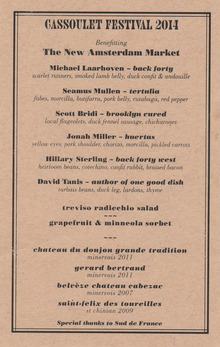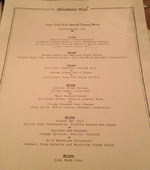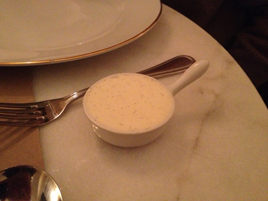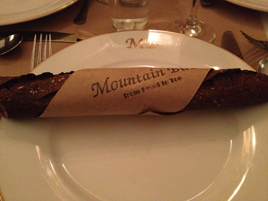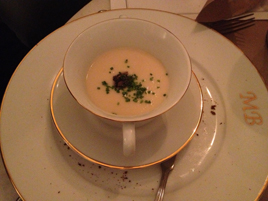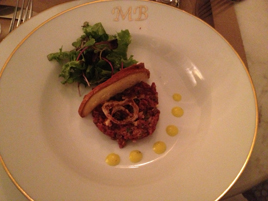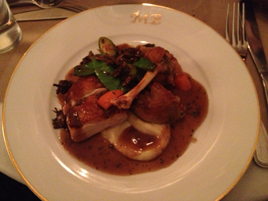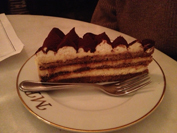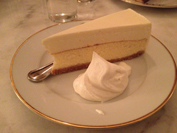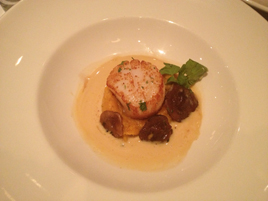Chicane
 Tuesday, June 17, 2014 at 05:38AM
Tuesday, June 17, 2014 at 05:38AM 
Note: Chicane closed for summer renovations in June 2014. Usually, such closures turn out to be permanent. Sure enough, Chicane closed for good in October. As we noted in our review (below), there were “abundant signs that the idea [wasn’t] well thought out.”
*
 Good casual French cuisine in New York has been on the upswing in recent years, but it’s still nowhere near plentiful enough. Italian restaurants and steakhouses with phoned-in menus open with regularity, but a new French restaurant almost always feels special.
Good casual French cuisine in New York has been on the upswing in recent years, but it’s still nowhere near plentiful enough. Italian restaurants and steakhouses with phoned-in menus open with regularity, but a new French restaurant almost always feels special.
 So it’s a pity that Chicane, which opened three months ago in Soho, is such a miserable example of the genre. It is not merely that the food was mediocre on the night we tried it: even good restaurants have off nights. But when fries are thick and mushy, it’s a sign that our visit wasn’t an anomaly: whatever else they do, French restaurants have to ace the frites in moules frites.
So it’s a pity that Chicane, which opened three months ago in Soho, is such a miserable example of the genre. It is not merely that the food was mediocre on the night we tried it: even good restaurants have off nights. But when fries are thick and mushy, it’s a sign that our visit wasn’t an anomaly: whatever else they do, French restaurants have to ace the frites in moules frites.
There are abundant signs that the idea isn’t well thought out. The South of France is the nominal theme at Chicane (named for a twisting section of track on the Monaco Grand Prix). But just a few dishes on the menu are captioned as specialties of that region. Many of the others, if they are French at all, could be found anywhere.
The chef, Andres Grundy, hails from Queens, not exactly a Monte Carlo suburb. He has worked at some very good restaurants at least briefly: Daniel, Le Cirque, Aquavit, Bouley, Daniel, Montrachet, Raoul’s (all in New York), two-star La Broche in Spain, L’Arpège in Paris. Since 2009 alone, he has been at Clio in Boston, then back in New York at L’Atelier de Joël Robuchon, Insieme, the Hotel Williamsburg, and now Chicane. By 2015 at the latest, I suspect he’ll be somewhere else.
Both the menu and the wine list are printed on frayed card stock that is already showing signs of ill-use. Sure enough, the first wine I chose was not available: the list had obviously not been re-printed anytime recently.
The menu is in the four-part format that is the current NYC standard, with “sharing plates and specialties” ($6–10; cheese plate $18), appetizers ($9–19), entrées ($19–32), and side dishes ($7). Those aren’t unfair prices, if only the food were better. Our server’s recommendations were generally the most expensive dishes, and after we’d ordered he tried to upsell us into even more.


Barbajuans ($8; above left), the national dish of Monaco, are puff pastries filled with Swiss chard and ricotta cheese. But I doubt the originals are as dry and bland as these. The Pissaladière ($10; above right) was made with a crust so thin that it crumbled instantly. Without enough bread to give it structure, the dish tasted like caramelized onion soup with anchovies and sliced olives lazily sprinkled on top.


There seemed to be nothing wrong with Mussels Marinières ($21; above left), but the mushy fries were a textural disaster (or nearly as disastrous as fries can be).


Lamb Shoulder ($28; above left) is braised overnight, but the goopy fat in this specimen looked as unpleasant as it tasted. For dessert, a Strawberry Vache ($12; above right) was decent enough.
The 75-seat dining room is decorated in a sunny Monaco motif (plenty of Grace Kelly photos). But the excessive din from the noisy bar, packed two deep, would have marred this potentially romantic spot, even if the food had been better. The bar, indeed, seems to be the scene here, as most of the tables were unoccupied at 8:00pm on a Wednesday evening. There is supposedly a subterranean cocktail lounge in the basement (mentioned in an UrbanDaddy piece), but with no reviews that I can find.
The owners clearly made an investment in this space, but if if they want to serve southern French cuisine, there is an additional investment they ought to consider: a chef from the South of France.
Chicane (430 Broome Street between Lafayette & Crosby Streets, Soho)
Food: Southern French cuisine…sort of
Service: Upsellingly obnoxious
Ambiance: A noisy beach in Nice, waiting for the chef to arrive
Rating: Not Recommended (no stars)
 Chicane in
Chicane in  Cuisines: French,
Cuisines: French,  Manhattan: SoHo,
Manhattan: SoHo,  Restaurant Reviews
Restaurant Reviews 














